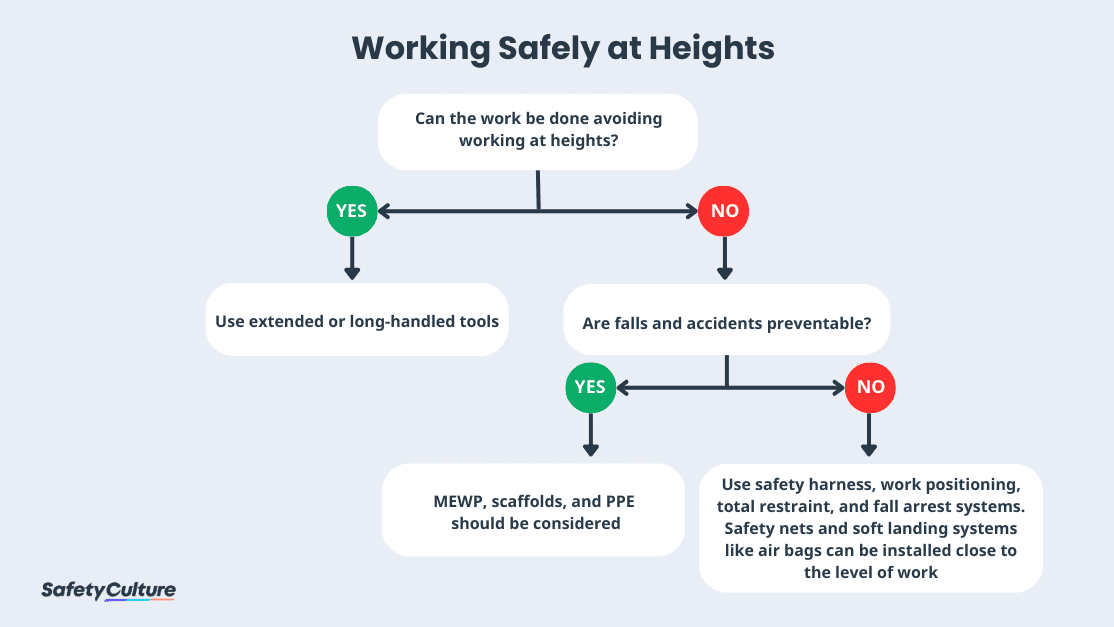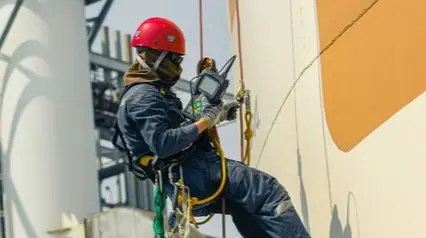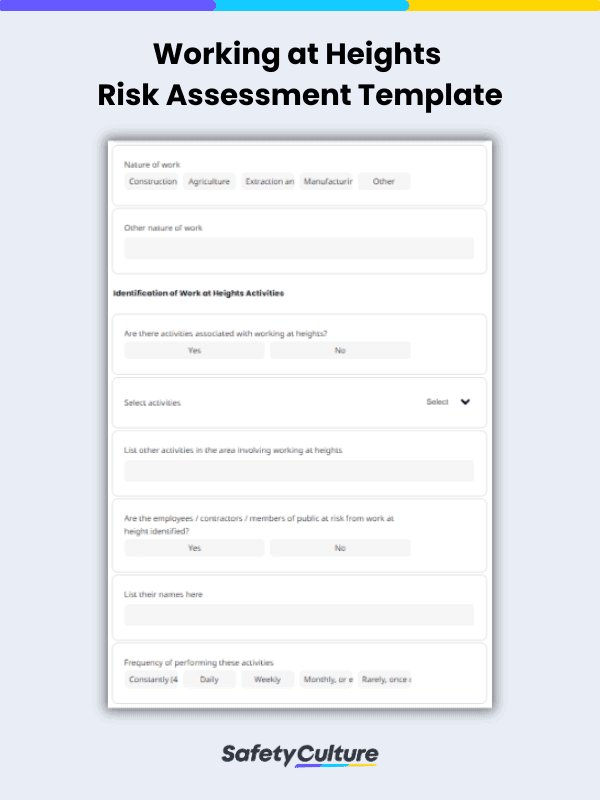What is Working at Heights?
Working at heights is defined as the performance of work at an elevated height of two meters or higher where workers are exposed to the injury of falling. This type of work is common in the construction industry. Working at heights is one of the biggest causes of preventable work injuries and fatalities around the world.
What is Working At Height Risk Assessment?
A working at height risk assessment evaluates hazards and risks associated with working above ground/floor level. It is both a moral and legal obligation of employers to have a risk assessment done prior to working at heights in order to formulate and implement preventive measures against potential injuries and fatalities associated with working at heights.
Same as a regular risk assessment, a risk assessing while working at height involves the following steps:
- Identify hazards
- Evaluate the risks and determine who may be harmed
- Decide on protective, precautions, and control measures
- Document findings and implement them
- Review and update if necessary
Top 5 Hazards to Check During Working at Heights Risk Assessments
Working at heights is dangerous in more ways than one. Several situations, elements, and factors contribute not only to the overall risk level, but also to the nature of the hazards safety officers and construction workers may face on any given day. Below are the top hazards encountered when working at heights:
1. Slips, Trips, and Falls
The lack of process implementation for idle tools and equipment can cause platforms to be littered; increasing the risk of accidental slips and trips which could lead to falls. Improper footwear can also cause slips and falls. Finally, workers who report for duty while under the influence of drugs or alcohol, or when ill or injured, are at a higher risk due to poor motor function.
Safety officers must ensure that control measures are in place in order to prevent such situations where the risk of slips, trips, and falls are increased.
2. Falling Objects
Another risk associated with the lack of a proper clean-up process are falling objects or objects that dropped from heights. This can cause personal injury to workers as well as damages to tools or equipment at the worksite. While workers may have tools, equipment, and materials on an elevated platform for easy access, designating areas in which necessary items should be placed can drastically reduce the chances of objects from being knocked out of the platform and potentially injuring workers below.
Safety officers must ensure that all workers, especially the ones working below elevated work areas wear hard hats at all times.
3. Faulty Work Platforms and Scaffolds
Elevated working platforms such as scaffolds and towers are essential for working at heights. It can also be extremely dangerous for workers if they happen to malfunction due to poor design and execution. Safety officers and scaffold competent personnel must ensure that elevated work platforms follow OSHA standards and are regularly inspected so structural issues are quickly identified and resolved.
4. Fragile Roofing
Roofs are not designed to handle the weight of workers. If they need to be used as working platforms, a proper assessment must be done in order to determine the control measures needed to ensure safety. Construction personnel can use roof ladders or crawling boards designed to distribute a worker’s weight evenly on a wider area; allowing the roof to safely sustain the added weight.
5. Inclement Weather
Strong winds can damage structures and elevated work platforms. Rain and snow can make surface areas slippery, and fog can reduce overall visibility. During inclement weather, the safest action to take is to halt construction work. If it is absolutely necessary, safety officers must ensure that all workers have the proper training, and are fitted with the appropriate PPEs to reduce the risk of incidents, injuries, and fatalities on the job.
Strategic Planning When Working At Heights
At the start of the job it is best practice to determine whether a task requires working at heights. Unless necessary, It is advisable to avoid working at heights and instead encourage workers to use extended or long handled tools for hard to reach locations.
In the event that the work requires working at heights, determine if falls and accidents are preventable. If so, proper equipment (i.e. Mobile Elevated Work Platforms, scaffolds, ladders, PPE) should be used and inspected at all times to ensure that they are in good working condition. If falls and accidents are at risk of occurring or not preventable then safety harnesses and fall protection landing gear should be installed.
Below is a flow-chart that summarizes the decision making process when planning on working at heights:
General Safety Tips for Working at Height
- Avoid working at heights when possible
- Use an existing safe place of work
- Minimize fall distance and consequences by using the right type of equipment
- Select quality PPE which is regularly inspected
- Always use the rails and fall protection barriers
- Be mindful of the fall distance. Never overload and overreach
- Determine the best anchor point to support you
- Select the correct gear when working at heights (scaffold, lift, ladder)
- Consider emergency and rescue procedures
- Train your team to be safety conscious
Working at Heights Risk Assessment Procedure
Construction workers should only work at heights when it is absolutely unavoidable. When the greenlight is given to work at height, the effective implementation of a standard procedure can drastically reduce the associated risks and hazards. Below is an example of a standard procedure when working at heights:
1. Perform a thorough inspection of elevated platforms and PPEs
Before any worker is allowed to work at height, elevated platforms such as scaffolds and towers, as well as fall arrest equipment and other PPEs, need to undergo a comprehensive inspection to ensure that they have no defects, damage, and design flaws. Aside from pre-use inspections, a maintenance inspection schedule should also be established.
2. Check the load-bearing capacity of platforms and fall arrest equipment
After ensuring that elevated platforms and personal fall arrest equipment are up to standard, verify their load-bearing capacity to ensure that you do not exceed recommended levels. For example, OSHA requires scaffolding to be able to bear at least four times the maximum intended load applied to it.
3. Check worker fitness and competency before allowing them to work at heights
Before allowing personnel to work at heights, safety officers must ensure that individuals have undergone and passed the training programs required for elevated work. Additionally, workers must be physically capable of working at heights and do not have pre-existing health conditions which may put them at a higher risk while performing their work. Lastly, workers must not be allowed to report for duty if they are under the influence of alcohol or recreational drugs.
4. Secure objects, equipment, and tools when elevated
While working at heights, procedures for securing objects, equipment and tools should be in place to prevent falling objects from injuring those who work at the ground level. Attachment points, tool lanyards, tool holsters, and tool belts are simple, low-cost control measures to reduce the likelihood of worker injury due to falling objects.
5. Immediately report identified risks and hazards to concerned personnel
Any worker who identifies risks or hazards, especially regarding working at heights, must immediately report them to concerned individuals. In such a scenario, work must be stopped immediately. A competent individual, in most cases the official safety officer, must ensure that the risks have been mitigated before allowing work to resume.
SafetyCulture Marketplace: Your One-Stop Work Gear & Equipment Shop
Improve safety in your workplace with SafetyCulture Marketplace as your one-stop shop for all work gear and equipment needs. Get on-demand access to top quality and specialized work gear from trusted equipment brands in the industry—all in one centralized location. Raise the bar of safety and efficiency by empowering employees to request what they need with just a few taps, anytime and anywhere!
FAQs about Working at Heights Risk Assessment
Working at height is a high-risk activity that requires comprehensive planning and following a lot of safety protocols. Understanding the risk it presents through regular assessments is crucial to ensuring the safety and well-being of workers in such situations. This includes identifying potential hazards, assessing their severity and likelihood, and implementing appropriate measures to mitigate or eliminate them.
A risk assessment should be done before performing a working-at-height task, allowing enough time to identify potential risks, evaluate their severity, and implement appropriate control measures. By doing this, any necessary safety precautions can be put in place to minimize the risk of accidents or injuries occurring during the work at height.
Some of the safety measures that can be implemented to minimize the potential hazards during work at heights include:
- conducting a risk assessment,
- giving workers proper training,
- using appropriate PPEs,
- providing the right equipment,
- eliminating other potential hazards, and
- encouraging open communication among team members and supervisors.



